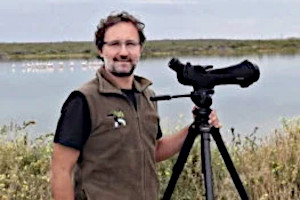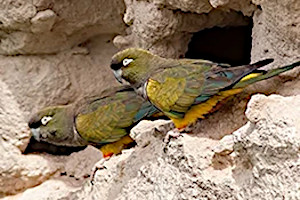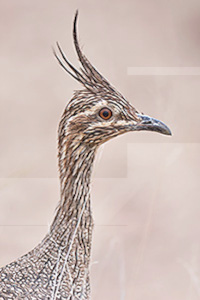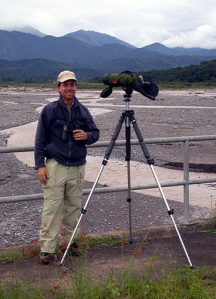
The Bird Watching Club for World Travelers |
|
Argentina
|
You don't need to be an expert birder to contact a Pal. Together you have love for nature, birds, new countries and learning.
These are serious birdwatchers willing to share their time to help you. It is a privilege to contact them. Your message should be respectful.
A Birding Pal does not charge a fee, however you should pay for their expenses, transportation costs, entrance fees, meals, etc.
Pals will answer your messages quickly, if they can. You might select someone who is traveling, so write to more than one Pal, and be patient. Let us know if someone doesn't answer and we'll check that everything is okay.
Let us know when you are going to meet a Pal, and then let us know how it went.
Happy birding.
|
Become a Pal Contact Birding Pal Admin Search this page: Press Ctrl and F |
J. Pereyra
Ciudad de Buenos Aires
Maps
Costanera Sur Ecological Reserve, Vicente Lopez Natural Reserve, Ribera Norte Natural Reserve, Lago Lugano Natural Reserve, Lago de Regatas Parke,
Available
Anytime
Languages
English
Note
My name is Javier, I have been a birdwatcher for several years. I started this activity as a hobby and it grew to become my greatest passion. I would like to share with tourists and visitors the natural beauty that Buenos Aires and its surroundings have to offer and meet people from other places who share the same passion.
My name is Javier, I have been a birdwatcher for several years. I started this activity as a hobby and it grew to become my greatest passion. I would like to share with tourists and visitors the natural beauty that Buenos Aires and its surroundings have to offer and meet people from other places who share the same passion.
Area
Costanera Sur Ecological Reserve; Vicente Lopez Natural Reserve; Ribera Norte Natural Reserve; Lago Lugano Natural Reserve; Lago de Regatas Park, and others.
Costanera Sur Ecological Reserve; Vicente Lopez Natural Reserve; Ribera Norte Natural Reserve; Lago Lugano Natural Reserve; Lago de Regatas Park, and others.
Area birds
Interests
Nature: birdwatching, twitching, photography
Visit: tourist site, museum, restaurant, monument, a architecture appreciation, shop, antique, fashion
Nature: birdwatching, twitching, photography
Visit: tourist site, museum, restaurant, monument, a architecture appreciation, shop, antique, fashion
Agustin Esmoris
Puerto Madryn / Peninsula Valdes area, Chubut
Maps
Puerto Madryn, Peninsula Valdes, Argentina
Available
Anytime
Languages
English

Note
I'm a passionate birding guide based in Puerto Madryn, Chubut, Patagonia, Argentina. With over 20 years of experience in nature photography, I've had the privilege of exploring various regions, including the Falkland Islands, Galapagos Islands, Canada, and Easter Island. My photography work has been featured in renowned publications such as National Geographic, Natural History Magazine, Lynx Edicions, and the American Museum of Natural History.
Birding has been a part of my life since childhood when I discovered the joys of this beautiful activity with my grandpa and dad. Today, I find immense pleasure in guiding birders and photographers to the very places that I know and love the most. With my deep connection to the natural world and my extensive knowledge of the local birdlife, I'm committed to creating unforgettable birdwatching experiences for enthusiasts from all around the world.
I'm also the proud author of the book "Birds of Birds of Peninsula Valdes," considered the most comprehensive and significant work on the birds of the eastern Patagonia region. This book is a testament to my dedication to avian conservation and sharing the wonders of our feathered friends with the world.
I look forward to welcoming you to Patagonia and sharing my passion for birds and nature in this breathtaking region. Together, we'll discover the incredible diversity of bird species and create memories that will last a lifetime. Let's embark on an unforgettable birdwatching adventure!
Company: Birding Puerto Madryn
Phone: +54.280.4194080
Email: agustin@birdingpuertomadryn.com
Website: www.birdingpuertomadryn.com

Area
Puerto Madryn/Peninsula Valdes and its surrounding region boast a remarkable diversity of bird species, making it a haven for birdwatchers. From the awe-inspiring coastal landscapes to the vast steppes, there's an array of habitats to explore and discover unique avian wonders.
Area birds
Argentina harbors 15 endemic bird species, most of which are restricted to the Monte desert. Our region is an ecotone that contains elements from both the Monte and Patagonian phytogeographic provinces. As a result, we have the opportunity to encounter five of the endemic species during our tours: Patagonian Canastero, White-throated Cacholote, Carbonated Sierra Finch, Steinbach's Canastero (AKA Chestnut Canastero) and Sandy Gallito. We also have the chance to observe near-endemics or 'breeding endemics' such as Band-tailed Earthcreeper, Rusty-backed Monjita, Lesser Shrike-Tyrant, Black-crowned Monjita, Burrowing Parakeet, Elegant Crested-tinamou, Straneck's Tyrannulet, and more.
Argentina harbors 15 endemic bird species, most of which are restricted to the Monte desert. Our region is an ecotone that contains elements from both the Monte and Patagonian phytogeographic provinces. As a result, we have the opportunity to encounter five of the endemic species during our tours: Patagonian Canastero, White-throated Cacholote, Carbonated Sierra Finch, Steinbach's Canastero (AKA Chestnut Canastero) and Sandy Gallito. We also have the chance to observe near-endemics or 'breeding endemics' such as Band-tailed Earthcreeper, Rusty-backed Monjita, Lesser Shrike-Tyrant, Black-crowned Monjita, Burrowing Parakeet, Elegant Crested-tinamou, Straneck's Tyrannulet, and more.

Interests
Birdwatching. Nature photography, hiking, birding, playing guitar, rock, blues.
L.Dodyk
Buenos Aires
Maps
Palermo, Argentina,
Available
Anytime
Languages
Spanish, English, Portugues
Note
I'm a naturalist. As a member of Aves Argentinas, I like sharing the areas in Buenos Aires where we are able to see a significant variety of bird species: R.E.C.S. Palermo and open areas in Buenos Aires
I'm a naturalist. As a member of Aves Argentinas, I like sharing the areas in Buenos Aires where we are able to see a significant variety of bird species: R.E.C.S. Palermo and open areas in Buenos Aires
Area
R.E.C.S. Palermo, Buenos Aires
R.E.C.S. Palermo, Buenos Aires
Area birds
Interests
Birdwatching
Birdwatching
Horacio Matarasso
Company: Buenos Dias Birding
Buenos Aires, CABA, Argentina
Maps
Pampas Iguazu Falls, Pampas, Buenos Aires, Argentina,
Available
Anytime
Languages
English, Spanish
Note
I'm a biologist and a passionate birder. I started birding at the high school in the '80, so I decided to study biology at Buenos Aires University to dedicate myself to ornithology and birding.
I used to work at BA University and at Western Washington University in ornithology of Argentina, and later to national universities about bird and management of the environment.
For 18 years I lived in Patagonia, where I was professor on Biology and Director of the Ornithology Center at Comahue National University, making census in different biogeographic habitats. Now I'm living in Buenos Aires, working as birding guide in Buenos Dias Birding, giving birding courses, and working about birds. I also colaborate in Wetlands international as memeber of the international board, in the organization of the South American Birdfair, as president of the International Comittee, and as member of Aves Argentinas / Birdlife International. I like birding and share this activity with other people I'll be glad to guide people from all the world in the places that I know and love.
I'm a biologist and a passionate birder. I started birding at the high school in the '80, so I decided to study biology at Buenos Aires University to dedicate myself to ornithology and birding.
I used to work at BA University and at Western Washington University in ornithology of Argentina, and later to national universities about bird and management of the environment.
For 18 years I lived in Patagonia, where I was professor on Biology and Director of the Ornithology Center at Comahue National University, making census in different biogeographic habitats. Now I'm living in Buenos Aires, working as birding guide in Buenos Dias Birding, giving birding courses, and working about birds. I also colaborate in Wetlands international as memeber of the international board, in the organization of the South American Birdfair, as president of the International Comittee, and as member of Aves Argentinas / Birdlife International. I like birding and share this activity with other people I'll be glad to guide people from all the world in the places that I know and love.
Area
Buenos Aires is a great hotspot with several natural reserves and surrounded by natural areas close to downtown. You can visit here undeveloped areas,open, with diverse habitats, some patches of typical cattle raising and a very rich birdlife, huge wetlands, forests and savannas and humid grassland of the Pampas for birding outing from 1 to 4 days. Miles of dirt roads allow easy birding, alternating walking and driving, and also spotting birds from the car.
The region is markedly “birdy” with abundant individuals and good levels of activity even at every season. From Buenos Aires you have completely different landscapes to visit, like Iguazu Falls on the North, surrounded by tropical rainforests, the Andes montains at the west, Patagonia at south, and others... to think in your next trip!.
Buenos Aires is a great hotspot with several natural reserves and surrounded by natural areas close to downtown. You can visit here undeveloped areas,open, with diverse habitats, some patches of typical cattle raising and a very rich birdlife, huge wetlands, forests and savannas and humid grassland of the Pampas for birding outing from 1 to 4 days. Miles of dirt roads allow easy birding, alternating walking and driving, and also spotting birds from the car.
The region is markedly “birdy” with abundant individuals and good levels of activity even at every season. From Buenos Aires you have completely different landscapes to visit, like Iguazu Falls on the North, surrounded by tropical rainforests, the Andes montains at the west, Patagonia at south, and others... to think in your next trip!.
Area birds
Saffron-cowled Blackbird, Blue-and-yellow Tanager, Southern Screamer, Greater Rhea, Strange-tailed Tyrant, Red-and-green Macaw, King Penguin, Andean Flamingo, Whistling Heron, Ruddy-headed Goose, Savanna Hawk, Band-tailed Manakin, Magellanic Woodpecker, Crested Gallito, Scimitar Billed Woodcreeper, Brown Cacholote, White Monjita, Jabiru, Toco Toucan, Glittering-bellied Emerald, Roseate Spoonbill, Golden Billed Saltator, Red Crested Cardinal, Guira Cockoo, Fork Tailed and Vermilion Flycatcher, Scarlet-headed Blackbird, Ibera Seedeater and several Seedsnipes, Tapaculos, Ducks, Tinamous, Flycatcher, Tanagers and Parrots.
Saffron-cowled Blackbird, Blue-and-yellow Tanager, Southern Screamer, Greater Rhea, Strange-tailed Tyrant, Red-and-green Macaw, King Penguin, Andean Flamingo, Whistling Heron, Ruddy-headed Goose, Savanna Hawk, Band-tailed Manakin, Magellanic Woodpecker, Crested Gallito, Scimitar Billed Woodcreeper, Brown Cacholote, White Monjita, Jabiru, Toco Toucan, Glittering-bellied Emerald, Roseate Spoonbill, Golden Billed Saltator, Red Crested Cardinal, Guira Cockoo, Fork Tailed and Vermilion Flycatcher, Scarlet-headed Blackbird, Ibera Seedeater and several Seedsnipes, Tapaculos, Ducks, Tinamous, Flycatcher, Tanagers and Parrots.
Interests
Nature: birdwatching, twitching, photography, butterflies, mammals and wildlife
Travel: car, walk, boats, horse
Visit: outdoors, nature spot, lake, ocean, reserves & national parks, museum, restaurant, vineyard,
Attend: Birdfairs
Participate: wine, beer
Nature: birdwatching, twitching, photography, butterflies, mammals and wildlife
Travel: car, walk, boats, horse
Visit: outdoors, nature spot, lake, ocean, reserves & national parks, museum, restaurant, vineyard,
Attend: Birdfairs
Participate: wine, beer

Diego Gallegos
Maps
Iguazu National Park, Argentina,
Available
Anytime
Languages
English
Note
In 1973, when I was 12, W. H. Hudson´s delightful “Far Away and Long Ago” fell into my hands. The birds, the nature and the people in those pristine pampas of 1850 were depicted so vividly that I was forever hooked. Time passed, and in 1984, I got my university degree (equivalent to a BSc) in Biology in the University of Buenos Aires. I worked many years as the manager of the birding conservation group Asociación Ornitológica del Plata (at present known as Aves Argentinas) and at the same time, I was called to guide my first group of birdwatchers. Since then, I led many other groups from the USA, UK or Europe, and more recently also individual travellers. At present I keep guiding for local and international travel agents, but most of my clients are individuals or couples that find me in the internet and contact me directly. Meet some of them - and have a look at their bird pictures - in the Birds & People section! Married to a biology teacher, we live with our four kids in a northern suburb of Buenos Aires. We spend much of our spare time in the countryside and we take every opportunity to travel around Argentina. The birding as I see it. The experience gave me a good understanding of what makes a successful birdwatching tour, and how this can change from one person to the other. Furthermore, I understand every outing as an excellent opportunity to meet people with a shared interest in birds an nature. A common interest that usually leads to conversations in many other subjects. Despite the long time I have been guiding, I keep having the same fun I had when I guided my first group. And I love to share that joy.
In 1973, when I was 12, W. H. Hudson´s delightful “Far Away and Long Ago” fell into my hands. The birds, the nature and the people in those pristine pampas of 1850 were depicted so vividly that I was forever hooked. Time passed, and in 1984, I got my university degree (equivalent to a BSc) in Biology in the University of Buenos Aires. I worked many years as the manager of the birding conservation group Asociación Ornitológica del Plata (at present known as Aves Argentinas) and at the same time, I was called to guide my first group of birdwatchers. Since then, I led many other groups from the USA, UK or Europe, and more recently also individual travellers. At present I keep guiding for local and international travel agents, but most of my clients are individuals or couples that find me in the internet and contact me directly. Meet some of them - and have a look at their bird pictures - in the Birds & People section! Married to a biology teacher, we live with our four kids in a northern suburb of Buenos Aires. We spend much of our spare time in the countryside and we take every opportunity to travel around Argentina. The birding as I see it. The experience gave me a good understanding of what makes a successful birdwatching tour, and how this can change from one person to the other. Furthermore, I understand every outing as an excellent opportunity to meet people with a shared interest in birds an nature. A common interest that usually leads to conversations in many other subjects. Despite the long time I have been guiding, I keep having the same fun I had when I guided my first group. And I love to share that joy.
Area
Iguazu, Missiones
Within the Iguazu National Park, a jungle environment predominates, whereby the falls an immense delta with a large number of islands are in reality like a magnificent wetland area. What better combination to find birds as are water and jungle! And there is more. Some bird species can only be found near the waterfalls. The magnificent Black-fronted Piping guan, without doubt the most handsome of guans of the Neotropics, frequents the falls area. Large trees, or rocks amidst the waters, are good spots to find this bird. Neither must we forget the incredible numbers of Great Dusky Swifts, with their spectacular diving flights, their nests hidden behind the walls of falling waters, and who have rightfully become the symbol of the Iguazu National Park and can be found on the Park's badge.
On checking these flocks closely and carefully, the White-collared Swift can sometimes be found among them, but it is present in small numbers only. Various swallow species can be observed near the falls, the Black-collared Swallow being the most searched after by birdwatchers. Among the aquatic vegetation you might discover the beautiful Yellow-billed Cardinal, the elusive Yellow-chinned Spinetail, and the modest Sooty Tyrannulet. Toucans, such as the Toco Toucan, or Chestnut-eared Araçari, are quite common near the falls. With luck, even the elusive Saffron Toucanet can be seen here. Herons, among them Striated Heron and Rufescent Tiger-heron, hunt and fish among the rocks, as well as cormorants and anhingas, diving for their food.
Somewhat rarer though is the Great Muscovy Duck, unmistakable in flight with its obvious white wing spots. In summer, high among the tree crowns, Swallow Tanagers amaze us with their intense blue and their notorious black mask, although the female in its green feather dress is no less attractive. The Greater Ani in its dark blue luminous dress is another summer visitor. In the early mornings we find parrots and parakeets perching and well visible in all their detailed dress, seemingly enjoying the spray produced by the falling waters. A few small raptors are also abundantly present, such as Snail Kite, which we see watching the waters intently, looking for their habitual prey, or the Yellow-headed Caracara. Less common is the Bat Falcon which can be seen catching large dragonflies but around dusk goes hunting for its preferred prey, the smaller bats. From time to time, an Osprey will also show itself.
Iguazu, Missiones
Within the Iguazu National Park, a jungle environment predominates, whereby the falls an immense delta with a large number of islands are in reality like a magnificent wetland area. What better combination to find birds as are water and jungle! And there is more. Some bird species can only be found near the waterfalls. The magnificent Black-fronted Piping guan, without doubt the most handsome of guans of the Neotropics, frequents the falls area. Large trees, or rocks amidst the waters, are good spots to find this bird. Neither must we forget the incredible numbers of Great Dusky Swifts, with their spectacular diving flights, their nests hidden behind the walls of falling waters, and who have rightfully become the symbol of the Iguazu National Park and can be found on the Park's badge.
On checking these flocks closely and carefully, the White-collared Swift can sometimes be found among them, but it is present in small numbers only. Various swallow species can be observed near the falls, the Black-collared Swallow being the most searched after by birdwatchers. Among the aquatic vegetation you might discover the beautiful Yellow-billed Cardinal, the elusive Yellow-chinned Spinetail, and the modest Sooty Tyrannulet. Toucans, such as the Toco Toucan, or Chestnut-eared Araçari, are quite common near the falls. With luck, even the elusive Saffron Toucanet can be seen here. Herons, among them Striated Heron and Rufescent Tiger-heron, hunt and fish among the rocks, as well as cormorants and anhingas, diving for their food.
Somewhat rarer though is the Great Muscovy Duck, unmistakable in flight with its obvious white wing spots. In summer, high among the tree crowns, Swallow Tanagers amaze us with their intense blue and their notorious black mask, although the female in its green feather dress is no less attractive. The Greater Ani in its dark blue luminous dress is another summer visitor. In the early mornings we find parrots and parakeets perching and well visible in all their detailed dress, seemingly enjoying the spray produced by the falling waters. A few small raptors are also abundantly present, such as Snail Kite, which we see watching the waters intently, looking for their habitual prey, or the Yellow-headed Caracara. Less common is the Bat Falcon which can be seen catching large dragonflies but around dusk goes hunting for its preferred prey, the smaller bats. From time to time, an Osprey will also show itself.
Area birds
Kudos
I had a couple of days to spare prior to a business meeting in Buenos Aires and wanted to do some birding. Not knowing where to go, how to get there or, in some cases, what I was seeing, I looked for a guide. I found Diego through an internet search and was glad I did. Over the course of a couple of days, he showed me many birds, took me to some interesting locations, found comfortable lodgings along the way and, most of all, was great company. I have birded in many countries around the world and Diego was as good an ambassador for his country and his country's avifauna as any other I have had.
-Rob W., New Jersey
I contacted Diego after reading about him on the Birdingpal website. We began to email each other in preparation for a trip from my home state of Florida to Buenos Aires, Argentina. When I couldn't find the book, Aves de Buenos Aires, here in Florida, Diego was able to get it for me. He picked us up (myself and my daughter) and took us to several different areas twice during the week that we birded with him. He made sure we had good looks at the birds and patiently helped us to identify them. Diego even managed to find a Golden-crowned Warbler for me, a species I had never been able to see in the U.S.A. During both trips, Diego made sure that we had food and drinks. Because I like to take photos of new birds (and I had many lifers while birding with Diego!), Diego made sure that we lingered long enough at each place for taking photos. Another reason why we enjoyed his services is that Diego is quite knowledgable about other wildlife and plants in the region, not just the bird species. If I travel to the Buenos Aires area in the future, Diego will be the first person I will call. I would highly recommend him to anyone who plans to bird there.
Sincerely, I. Hernandez, Redington Shores, FL
I had a couple of days to spare prior to a business meeting in Buenos Aires and wanted to do some birding. Not knowing where to go, how to get there or, in some cases, what I was seeing, I looked for a guide. I found Diego through an internet search and was glad I did. Over the course of a couple of days, he showed me many birds, took me to some interesting locations, found comfortable lodgings along the way and, most of all, was great company. I have birded in many countries around the world and Diego was as good an ambassador for his country and his country's avifauna as any other I have had.
-Rob W., New Jersey
I contacted Diego after reading about him on the Birdingpal website. We began to email each other in preparation for a trip from my home state of Florida to Buenos Aires, Argentina. When I couldn't find the book, Aves de Buenos Aires, here in Florida, Diego was able to get it for me. He picked us up (myself and my daughter) and took us to several different areas twice during the week that we birded with him. He made sure we had good looks at the birds and patiently helped us to identify them. Diego even managed to find a Golden-crowned Warbler for me, a species I had never been able to see in the U.S.A. During both trips, Diego made sure that we had food and drinks. Because I like to take photos of new birds (and I had many lifers while birding with Diego!), Diego made sure that we lingered long enough at each place for taking photos. Another reason why we enjoyed his services is that Diego is quite knowledgable about other wildlife and plants in the region, not just the bird species. If I travel to the Buenos Aires area in the future, Diego will be the first person I will call. I would highly recommend him to anyone who plans to bird there.
Sincerely, I. Hernandez, Redington Shores, FL
Francisco Cornell
Jujuy, Argentina
English, Spanish
Maps
Buenos Aires, Pampas, Lake Vilama Lake Polulos Puna Steppes Yungas Cloud Forest
Available
Anytime
Languages
English, Spanish
Note
Francisco Cornell was born in Buenos Aires (1972), but has lived in the Province of Jujuy, since he was 6 years old.
He was always fascinated with nature, motivated by the beautiful landscapes, wildlife and incredible night skies of the Andes. He became a birdwatcher at the age of 23, and has since spent many years traveling throughout the region birding and know very well the birds of the region. Taking part in several nature conservation projects, he developed a special interest for the Andean and its threatened bird species.
In 2000 he began working as a birdwatching guide, then became an official guide of the Calilegua NP and developed “Birding Jujuy” to lead people around the region. At present, he is one of the authors of the Bird Checklist of Jujuy Province (with 577 species), got a degree in tourism and is married with a beautiful daughter.
Kudos
Francisco guided me during my second trip to Argentina and I can recommend him as a knowable and very pleasant guide, who knows where to find the local rarities around Jujuy. Less than half an hour into our tour he spotted Torrent Ducks and Rufous-throated Dippers both lifers for me plus many more birds. Knud Rasmussen. Toronto, Canada.
Francisco Cornell was born in Buenos Aires (1972), but has lived in the Province of Jujuy, since he was 6 years old.
He was always fascinated with nature, motivated by the beautiful landscapes, wildlife and incredible night skies of the Andes. He became a birdwatcher at the age of 23, and has since spent many years traveling throughout the region birding and know very well the birds of the region. Taking part in several nature conservation projects, he developed a special interest for the Andean and its threatened bird species.
In 2000 he began working as a birdwatching guide, then became an official guide of the Calilegua NP and developed “Birding Jujuy” to lead people around the region. At present, he is one of the authors of the Bird Checklist of Jujuy Province (with 577 species), got a degree in tourism and is married with a beautiful daughter.
Kudos
Francisco guided me during my second trip to Argentina and I can recommend him as a knowable and very pleasant guide, who knows where to find the local rarities around Jujuy. Less than half an hour into our tour he spotted Torrent Ducks and Rufous-throated Dippers both lifers for me plus many more birds. Knud Rasmussen. Toronto, Canada.
Area
Buenos Aires is a great hotspot with several natural reserves and surrounded by natural areas close to downtown. You can visit here undeveloped areas,open, with diverse habitats, some patches of typical cattle raising and a very rich birdlife, huge wetlands, forests and savannas and humid grassland of the Pampas for birding outing from 1 to 4 days. Miles of dirt roads allow easy birding, alternating walking and driving, and also spotting birds from the car.
The region is markedly “birdy” with abundant individuals and good levels of activity even at every season. From Buenos Aires you have completly different lanscapes to visit, like Iguazu Falls on the North, surrounded by tropical rainforests, the Andes montains at the west, Patagonia at south, and others... to think in your next trip!.
Buenos Aires is a great hotspot with several natural reserves and surrounded by natural areas close to downtown. You can visit here undeveloped areas,open, with diverse habitats, some patches of typical cattle raising and a very rich birdlife, huge wetlands, forests and savannas and humid grassland of the Pampas for birding outing from 1 to 4 days. Miles of dirt roads allow easy birding, alternating walking and driving, and also spotting birds from the car.
The region is markedly “birdy” with abundant individuals and good levels of activity even at every season. From Buenos Aires you have completly different lanscapes to visit, like Iguazu Falls on the North, surrounded by tropical rainforests, the Andes montains at the west, Patagonia at south, and others... to think in your next trip!.
Area birds
Interests
Birdwatching
Birdwatching


